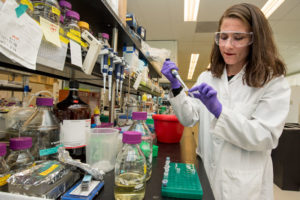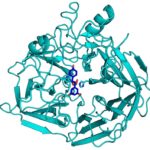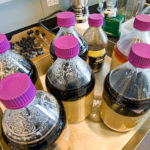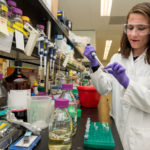 Researchers at the Department of Energy’s Lawrence Berkeley National Laboratory (Berkeley Lab) and Sandia National Laboratories working at the Joint BioEnergy Institute (JBEI) have resolved the protein structure of the enzyme LigM, which is utilized by the soil bacterium Sphingomonas to metabolize aryl compounds derived from lignin, the stiff, organic material that gives plants their structure. Their work is reported in this week’s Proceedings of the National Academy of Sciences. Read more in the Berkeley Lab News Center.
Researchers at the Department of Energy’s Lawrence Berkeley National Laboratory (Berkeley Lab) and Sandia National Laboratories working at the Joint BioEnergy Institute (JBEI) have resolved the protein structure of the enzyme LigM, which is utilized by the soil bacterium Sphingomonas to metabolize aryl compounds derived from lignin, the stiff, organic material that gives plants their structure. Their work is reported in this week’s Proceedings of the National Academy of Sciences. Read more in the Berkeley Lab News Center.
Finding Diamonds in the Rough
New crystallography finding by JBEI and GLBRC benefits bioenergy industry
 During the kraft process used to convert wood into wood pulp, the structural material lignin is partially converted into molecules like stilbene. Stilbenes are also naturally occurring in plants and some bacteria, and may play a role in plant pathogen resistance.
During the kraft process used to convert wood into wood pulp, the structural material lignin is partially converted into molecules like stilbene. Stilbenes are also naturally occurring in plants and some bacteria, and may play a role in plant pathogen resistance.
Currently, the deconstruction of plant biomass into cellulose and lignin is an expensive process. Lignin accounts for about 30 percent of plant cell wall carbon, and its conversion into chemicals or fuels could have a significant positive impact on the economics of processing lignocellulosic biomass. Enzymes capable of producing useful compounds from the breakdown of stilbenes and similar molecules could be employed for this. Collaborators from two of the Department of Energy Bioenergy Research Centers now have gained first-hand insight into how a stilbene cleaving oxygenase (SCO) carries out this unusual chemical reaction.
JBEI Scientists Harness CO2 to Consolidate Biofuel Production Process
 JBEI scientists have shown that adding carbon dioxide gas during the deconstruction phase of biofuel production successfully neutralized the toxicity of ionic liquids. The technique, which is reversible, allows the liquid to be recycled, representing a major step forward in streamlining the biofuel production process. Read more on the Berkeley Lab Newscenter
JBEI scientists have shown that adding carbon dioxide gas during the deconstruction phase of biofuel production successfully neutralized the toxicity of ionic liquids. The technique, which is reversible, allows the liquid to be recycled, representing a major step forward in streamlining the biofuel production process. Read more on the Berkeley Lab Newscenter
Biosciences Area Participates in DOE’s Big Ideas Summit
 On April 21 and 22, 2016, the Department of Energy (DOE) hosted the National Laboratory Big Ideas near Washington, D.C. The Summit was the third annual gathering to elicit large-scale, potentially game-changing ideas from DOE’s 17 national laboratories working collaboratively to tackle the nation’s energy and science challenges. A theme of this year’s Summit was the Presidential Mission Innovation initiative to dramatically accelerate global clean energy innovation to address climate change.
On April 21 and 22, 2016, the Department of Energy (DOE) hosted the National Laboratory Big Ideas near Washington, D.C. The Summit was the third annual gathering to elicit large-scale, potentially game-changing ideas from DOE’s 17 national laboratories working collaboratively to tackle the nation’s energy and science challenges. A theme of this year’s Summit was the Presidential Mission Innovation initiative to dramatically accelerate global clean energy innovation to address climate change.
ESOC Welcomes French Synthetic Biology Delegation
 Emery Station Operations Center (ESOC) welcomed a French Synthetic Biology Delegation on April 13. The delegation was led by the IAR Cluster (Pôle de Compétitivité IAR), which brings together more than 320 stakeholders from research, higher education, industry (SMEs and large companies) and agriculture with a common goal: the optimal valorization of renewable resources. IAR’s four R&I fields include biofuels, biomaterials (biopolymers and bio-composites), biochemicals and bio-ingredients.
Emery Station Operations Center (ESOC) welcomed a French Synthetic Biology Delegation on April 13. The delegation was led by the IAR Cluster (Pôle de Compétitivité IAR), which brings together more than 320 stakeholders from research, higher education, industry (SMEs and large companies) and agriculture with a common goal: the optimal valorization of renewable resources. IAR’s four R&I fields include biofuels, biomaterials (biopolymers and bio-composites), biochemicals and bio-ingredients.
- « Previous Page
- 1
- …
- 3
- 4
- 5
- 6
- Next Page »
Was this page useful?




